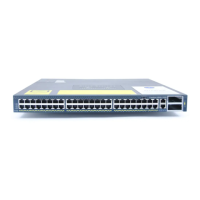126 Cisco LAN Switching Configuration Handbook
Note Enabling PortFast on a port also prevents TCN BPDUs from being generated due to
a state change on the port. Although STP is still operating on the port to prevent bridging
loops, topology changes are not triggered when the attached host goes up or down.
You should use the PortFast feature only on switch ports where single hosts connect. In
other words, don’t enable PortFast on switch ports that connect to other switches or hubs,
whether the ports or trunking.
b. (Optional) Enable PortFast BPDU Guard to improve STP stability:
(global) spanning-tree portfast bpduguard
On a nontrunked port with PortFast enabled, BPDU Guard moves the port into
the Errdisable state if a BPDU is detected. You can use enable or disable to con-
trol the BPDU filtering state on the port. Use the default keyword to return the
port to the global default set by the optional command set spantree global-
default bpdu-guard {enable | disable}.
On the Supervisor IOS, BPDU Guard is enabled globally on all ports that have
PortFast enabled.
c. (Optional) Enable PortFast BPDU Filtering to stop BPDU processing on a port:
(interface) spanning-tree bpdu-filter
BPDU Filtering causes the switch to stop sending BPDUs on the specified port.
As well, incoming BPDUs on that port will not be processed. You can use enable
or disable to control the BPDU Filtering state on the port.
3. (Optional) Use UplinkFast STP convergence for access layer uplinks:
(global) spanning-tree uplinkfast [max-update-rate packets-per-second]
The switch can generate dummy multicasts at a rate up to station-update-rate per
100 milliseconds (Catalyst OS, default 15 per 100 ms) or packets-per-second
(Supervisor IOS, default 150 packets per second). The all-protocols keyword gener-
ates multicasts for each protocol filtering group.
4. (Optional) Use BackboneFast STP convergence for redundant backbone links:
(global) spanning-tree backbonefast
When used, you should enable on all switches in the network. BackboneFast is
enabled or disabled for all VLANs on the switch.
7-4: Navigating the Spanning-Tree Topology
Although navigating a spanning-tree topology is a rather tedious process, it is usually the
only way to verify that the STP is operating as it was intended. Many times, you will have
a diagram of the switches in the network showing the physical or logical interconnections.
The spanning-tree topology, however, usually goes undocumented until there is a problem.

